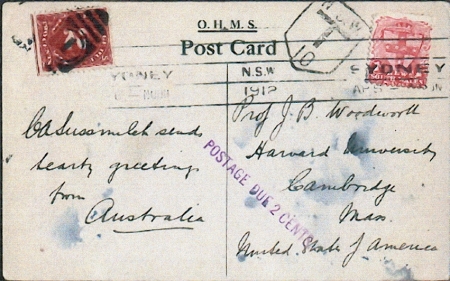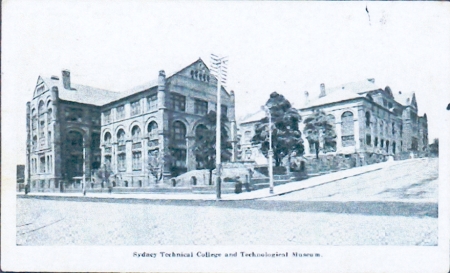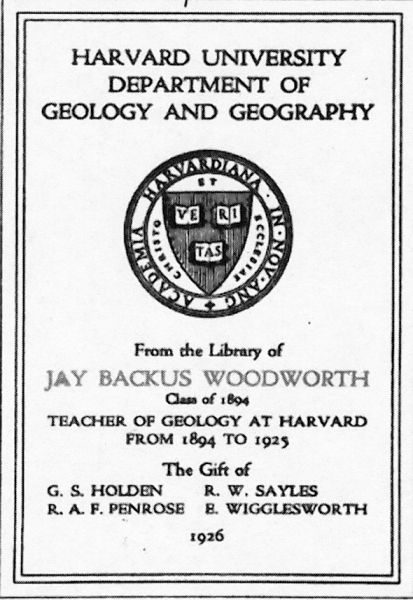The O.H.M.S. postcard was sent from C.A. Sussmilch ‘with hearty greetings from Australia’ to Prof. J.B. Woodworth, Harvard University, Cambridge, Mass. The red 1d ‘Shield’ stamp of New South Wales was postmarked with a SYDNEY roller cancel dated AP 5/ NOON/ 1912. The postcard was taxed with a N.S.W./ T/ 10, as well as a purple handstamp POSTAGE DUE 2 CENTS, and the red 2d U.S. postage due stamp was cancelled with a numeral 1 (Figure 1).

The reverse shows a fine photo of the Sydney Technical College and Technological Museum (Figure 2).

The Sydney Technical College was established in 1878, taking the place of the Sydney Mechanics Institute. In 1949 the New South Wales University of Technology operated from the College’s campus before moving to its own campus in Kensington. The Sydney Technical College later hatched the New South Wales Institute of Technology, which became the University of Technology Sydney. The College continued to operate, eventually becoming the Ultimo Campus of TAFE (Technical And Further Education), New South Wales. At the time of the postcard, Carl Adolf von Heyne Sussmilch (1875-1946) was a geologist and teacher at the College. He published many scientific papers on the subject of geology, and his ‘First Year, Practical Course: Determination of Rocks’ went through four editions. His ‘An Introduction to the Geology of New South Wales’ had at least two editions. He was held in high repute in Australian geology, for he was a Fellow of the Geographical Society and in 1939 he delivered the prestigious Reverend W. B. Clarke Memorial Lectureship in geology of the Royal Society of New South Wales.
Recently there has been conjecture about the origin of the famous Big Rock at Ben Buckler, Bondi, and Carl Sussmilch is very much at the centre of this controversy. It revolves around a brass plaque fixed to the north west side of the Rock, put there in 1933, and it tells of its origin and weight. “This rock weighing 235 tons was washed up from the sea during a storm on 15th July 1912”. There were many weather reports about the severe storms of 1912: The Sydney Morning Herald on Monday the 15th July described the previous Saturday’s “monsoonal conditions from a cyclonic disturbance between Lord Howe Island and the central coast of NSW.” According to SMH the “fierce southerly gales” were around 49-71mph [55-113 kph].
Two weeks later The Daily Telegraph published a photo with the caption: “Huge rock displaced and rolled some distance by the recent heavy seas off Bondi. Marine growth on the upper portion of the rock, as it now stands, shows that the section to have been under water for some time, whilst the lower portion previous to the mass having been overturned, was apparently above water at low tide.
Mr C. A. Sussmilch Fellow of the Geographical Society (when he was a lecturer at the Sydney Technical College) wrote a scientific article about how the Rock first appeared. He presented his theory to the Royal Society of NSW on September 4, 1912. “On the 15th July of this year an unusually heavy sea, caused by a storm some distance away in the Tasman Sea, did considerable damage along the coast of New South Wales. He showed a huge block of sandstone thrown up by the waves at the foot of the headland on the northern side of Bondi Bay. This block measured 20 feet long, 16 feet wide and 10 feet high…cubical content 3520 cubic feet…15 cu.ft sandstone weighs one ton…weight must be about 235 tons. This information has been extensively discredited in a local Bondi internet publication recently, but no real alternative was presented.
Jay Backus Woodworth (1865-1925), American geologist worked on the glacial and structural geology of New England as well as the geology of South America. He spent his entire career at Harvard, graduating with a B.Sc Harvard in 1894, and he first became an instructor in geology there. He was appointed as an assistant professor for 5 years from September 1, 1906, rising to a full professor. He was particularly notable for seismology, and he organised the Harvard seismographic station. He served as chairman of the National Research Council Committee on the Use of Seismograph in World War I in 1917-18 and was president of the Seismographical Society of America from 1916 to 1918. He published frequently from the early 1880s to1924, his memorial was published in the Bull. Geol. Soc. Am. 1926 37 134-141, and his papers are held in the Harvard University Archives, Pusey Library, Cambridge , Mass. A copy of his bookplate is seen Figure 3.

short but interesting communication between two geologists, one in Australia, the other in the USA.